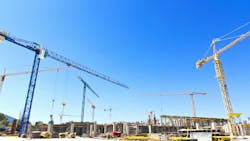The only thing worse for construction contractors than failing to consistently win enough profitable new business might be sinking resources into projects that never advance beyond preconstruction.
But that’s what more contractors and design firms may be facing as mounting economic uncertainty takes its toll in the form of abandoned construction projects. By at least one measure, the volume of non-residential and multifamily residential projects that owners or developers are pulling the plug on this year is on an upward trajectory.
Construction data firm ConstructConnect says its Project Stress Index (see Figure) shows that project abandonment activity surged 66% between year-end 2024 and the end of May 2025. Abandonments in the private sector have outpaced those in the public sector and reached their highest level since data collection began in 2019, the company says.
Two other index components — on-hold activity and bid-date delays — have been less volatile this year. Bid-date delays increased 4.3% but hold activity declined 18.5% through the end of May.
The May 2025 reading on abandonment activity put it at its highest level since February 2024. That activity, and the index overall, fluctuated during 2024, but the trendline was down. The index bottomed out at around 60% of its February value near year end before resuming a march upward earlier this year.
Index volatility, ConstructConnect says, is partly a function of gyrating views on the economics of construction. Uncertainty on where interest rates are heading, whether new tariff policies will lead to higher materials costs, and whether immigration policies could lead to higher labor costs is complicating decision making. Project developers and owners are having to recalibrate their thinking more frequently on project viability. It’s curtains for projects when they conclude they no longer pencil out based on projections or new hard realities.
In a June release announcing the May index reading, ConstructConnect economist, Devin Bell, blamed growing pessimism and a sticky-high cost of capital for the uptick since May 2024: “Comparing May 2024 to May 2025, we see pronounced differences in both bid-date delays (which have risen 4.3%) and abandonment activity patterns. We believe that significant changes in market outlook, along with elevated and sustained interest rates, are having a growing impact on projects in their preconstruction phases.”
If the first half of 2025 is any indication, the latter half of the year could bring even more calculating approaches to preconstruction decision making. The pace of abandonments could rise if uncertainty persists, but so, too, could the pace of bid-date delays and holds if owners and developers see rising risks of even taking the first steps toward project initiation.
That may be a signal for contractors to be even more diligent in vetting the prospects for construction projects staying on course. Greg Padalecki, president/CEO of Alterman, Inc., a San Antonio, Texas-based electrical contractor, offers the reminder that “as subcontractors we often end up doing free preconstruction work.” With a growing focus on datacenter and mission-critical work, Alterman has been more able to steer around projects that look risky in various ways.
“No one is slowing down datacenter or water projects, and so we’ve been able to stay away from more of those subjective spending projects,” he says. “And when funding gets reduced on something like a mixed-use retail or airport infrastructure project the scope is reduced as well.”
But changes in the economic backdrop could change the entire script. A start down the path of lower interest rates via a Federal Reserve rate cut decision could be the primary game changer, giving developers more confidence that they can make the numbers work. On the flip side, though, lower interest rates could be a harbinger of a looming recession, which history clearly shows is not at all good for construction.
About the Author
Tom Zind
Freelance Writer
Zind is a freelance writer based in Lee’s Summit, Mo. He can be reached at [email protected].
